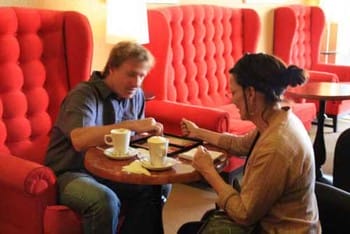An experience at Matteo, a new coffee house on Church Street will guarantee you much more than a hot beverage. Matteo is a modern coffee and tea joint started by the Sterling Mac group (Mac fast food) and is already attracting a sizable group of people.

Their walls are plastered with boards explaining the coffee harvesting process and their pillars have facts about tea. Pic: Meghna Raghunathan.
This coffe house opened on December 21st and it boasts of some of the best coffee in the country with imported varieties from all over the world and tea in silk sachets. According to the manager, Partha S, "A regular coffee drinker will be able to taste the difference."
While one may imagine five star prices, Matteo’s prices are not too high, with coffees and desserts ranging from Rs 50 – Rs 100.
What sets this coffee house apart is its focus on promoting coffee education. While the concept of a "silk sachet" and the name "Robusta Arabica" leaves many of us baffled, Matteo takes it upon itself to make sure the customer knows exactly what that means by "educating people of great coffee".

Matteo has introduced concepts like brew of the day and also customise coffees as per customer’s orders. Pic: Meghna Raghunathan.
Their walls are plastered with boards explaining the coffee harvesting process and their pillars have facts about tea. After a visit to Matteo one will know everything from the "wet method" (the method of coffee processing where the fruit covering the coffee beans are removed before they are dried) of processing to the fact that coffee was first discovered by a goat herder. They have introduced concepts like ‘brew of the day’, to further the experience and they also customise special coffees as per customer’s demands. According to Partha S, Matteo aims to promote more of an experience and education than a meal.
What many noticed about this coffee house is that there was no television set and that one could hear the other over the music. Partha says, "It really irritates me when you have to keep asking, "I can’t hear you, can you hear me?" Matteo maintains more of a relaxed, rather than a party setting. It is not odd to find people sitting and staring at their computers, as the coffee house if fully Wi-Fi enabled. According to Partha, Matteo aims to maintain more of a relaxed "organic feel".
Bismati S, a student of Mount Carmel College, on a first time visit to Matteo said that Matteo has "one of the best ambiences in Bangalore" and that it was "warm and cozy." If you want to understand the coffee making process or just relax with your laptop, Matteo is the place to be. ⊕
Nice coffee place……any comparison’s with Coffee Day…any case this attracts only a certain type of clientele…niche market!